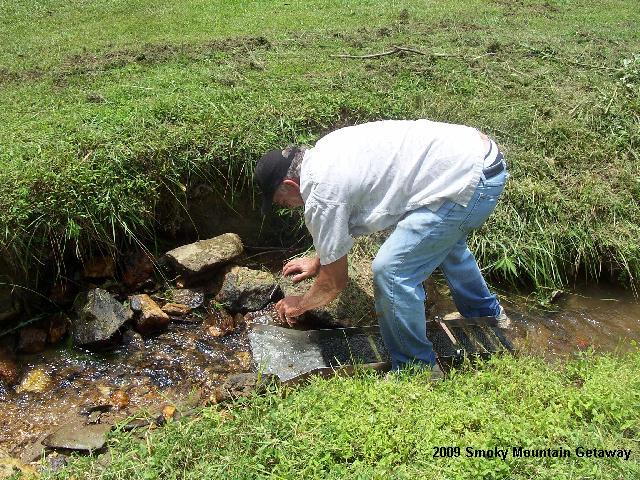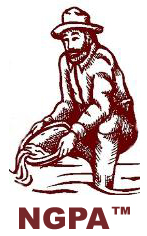Looking for Gold in Unlikely Places

With the price of gold soaring and people losing jobs, going after gold may be a profitable idea. If you are an Easterner, it might be nice to know you don’t need to head west to the old gold fields of Colorado and California. Gold is found in most eastern states and there have been gold rushes in the east. The most famous being the 1829 rush to Georgia. Here are just a few of the eastern states you can explore with your pan, pick and shovel.
Places to check out in Alabama are Goldville and Arbacoochee. It was here in the 1830’s and 1840’s that placer mining was prominent. Miners moved to California during the gold rush but gold still remains in Alabama, so take your pan and find a stream. Another place to head for in this state is Hog Mountain where gold has been mined. The Arbacoochee gold district is in southern Cleburne County. It was where the richest p1acers were worked. There are also closed gold mines in this area and places near Gold Hill along Clear Creek.

In Tallapoosa County there is the Hog Mountain Gold District. Gold was first discovered here in vein form in 1839. The Hog Mountain Mine was the largest producer in Alabama but there were more mines and it is likely that more gold veins exist in this area. So bring your pick and shovel.
Now, let’s take that detector, pick, shovel and pan and head for Georgia. This was the location of the first gold rush in America. Before 1900, Georgia produced $17 million in gold.
Go to Cherokee County where there has been gold mining since 1840. The most famous mine was the Franklin. Look in the area of the Etowah River for this gold. It will probably be found in veins but placing a pan in the river might be worthwhile.
Lumpkin County is a good place to try for gold. Placering in the streams and creeks of this county could be profitable. It began in 1828. The gold areas in this county are worked due to the rise of gold prices, so now would be a good time to hit it here.
Gold was discovered in White County in 1829. The mines were worked and they still should be profitable today as the price of gold rises. The starting point would be the town of Nacoochee.
Gold in Michigan? Yes! Go to the Upper Peninsula, about three-to-five miles west-northwest of Ishpeming on the north side of the Marquette Range in Marquette County. Gold was discovered here in the 1840’s. The most famous mines were the Ropes. This is vein gold and close to the surface.
North Carolina, believe it or not, is a huge gold-producing state. A 17-pound nugget was found here in 1799 on the Reed plantation in Cabarrus County.
Burke County is a very good source of go1d. It is mostly placering but some veins have been worked. They were first worked in 1828 and by 1916 over 50,000 of gold had been produced. They are called the Brindletown placers and they are 13 miles southwest of Morgantown. The Upper part of First Broad River is a good location. Richland Mountain near Brindletown is another good site to explore. Gold has also been found in the South Mountains in this same area.
Go to Cabarrus County and then find the town of Concord, six miles southeast is the Phoenix mine. It was discovered in 1856 and is the area to look in this county.
Another mine famous in this county is the Reed Mine. It was discovered in 1799 and it’s where many mines were worked. As of 1948, the mines had produced more than one million dollars in gold and that was at the old, low prices. This area is worth the trip.
Over in Davidson County is the Cid district, which is 1,255 square miles. There have been mines worked in the area and more veins could still exist. They previously weren’t rich mines but now might see a better yield. Some of the old mines might even be worth checking out. And remember the mine tailings.
Franklin County is a likely place to placer. You need to go to Portis in the northeast corner, find the wood post office and go east. This should be a good place.
Another good spot is the town of Kings Mountain and then two miles south to the Kings Mountain Mine. From 1834 to 1900, it produced over a million dollars in gold. Below the mine and in all the streams near the mine is where you need to placer. This will be your best bet locating gold.
There was much gold production in Guilfor County and there were quite a few mines, but unless you live close by, it might not be worth a trip – but one never knows. The mines here were Gardner Hill, Lindsay, North States and Jack’s Hil1. This gold area is in the southern part of
the county. The place to go is eight to 12 miles south of Greensboro. Gold may still be in the area. These mines were worked until 1880’s.
There are two gold mines in the city of Charlotte – the St. Catherine and the Rudisil. Both mines have been worked off-and-on for years. In 1829, the Rudisil Mine produced $30,000 in one month. You have to wonder what would that value would be today. So, if you live in the city of Charlotte, and you can find undeveloped land, you might be lucky.
Two miles west of the town of Candor in Montgomery County, gold has been found and mines have been worked. Two mines produced 50,000 ounces and the area could yield more.
Also in Montgomery County are the Russell and Steel mines. These mines are two-to-three miles west of Ophir along the Uwharrie River, so this area and river might be excellent for panning and vein searching.
In Randolph County, 12 miles west of Ashville, is the Hoover Hill Mine. This mine has been worked off-and-on and was owned by a company in England. This area might be good for vein searching and the mine has produced 17,000 ounces.
The Gold Hill District in Rowan County is one of the rich districts of the state and one of the oldest. Gold was first found here in 1824 and this is the place to go. The gold strip is 18 miles long and eight miles wide in the southeastern part of the county. It extends from the Yadkin River to the town of Mount Pleasant. The center of the district is the town of Gold Hill. This area had produced millions of dollars in gold since those early days. The main mines are the Randolph, the Barnhardt, the Old Field, the Honeycutt, the Troutman, the Union Copper and the Whitney.
Panning the streams might be worthwhile and well worth the visit.
The Parker Mine is located in Stanley County. This mine is located in the northern part of the county near the town of New London. This area was known for both vein and placer mining. In 1935, a new vein was found and it started new interest in the area. More veins may be waiting to be discovered.
A definite place to go is the Fairfield Valley placers in southern Transylvania County in the northern drainage area of the Toxaway River. Also search Georgetown Creek. One tributary creek alone yielded 15,000 ounces.
Union County is a gold-bearing region of North Carolina where gold was discovered in 1840. The largest lode mine was three miles northwest of the town of Waxhaw. In 1854 alone, it produced $250,000. There also has been placer mining in this county, so the streams should be good. The streams here should sti11 be productive.
In Pennsylvania, the southern part of Lebanon County is producing gold. The Cornwall Iron Mine, in operation since 1742, has yielded an excellent amount. This area might be worth looking into for undiscovered deposits.
South Carolina is not as well-known for gold production as Georgia and North Carolina, but there has been both lode and placer mining. In Chesterfield County, placer gold deposits were first worked in 1828. Vein deposits were also discovered there. The Brewer Mine is west of Jefferson in the northwest part of the county.
Lancaster County has the most productive mine in the southeast United States. It is the Haile Mine, 3 1/2 miles northeast of Kershaw, South Carolina. Gold placers were worked here as early as 1827. The California gold rush pulled most everybody away but the discovery of gold continued. Searching for new placers and new mines could be profitable in this county.
McCormick County is a gold producing area in the Carolinas, but only one mine (Dorn) has ever been worked. Its first shipment was valued at $300,000, so it was an extremely-profitable mine. This area might be interesting to search for other sources of gold but it would be advisable to research the area first before making a trip.
There are gold bearing regions in Virginia and they are east of the Blue Ridge Mountains. It is a lot of territory. The gold-bearing area ranges from 25 miles wide to 200 miles in length.
Thomas Jefferson first made the mention of gold in this state. Gold ore was found in 1782 along the Rappahannock River and there is stil1 vein and placer gold here. Vein gold has been found in Fauquier County and the Franklin Mine, which has produced over 10,000 ounces of metal, is located three miles south of Morrisville. This county could be a likely place to search for other veins.
Placer and lode mines can be found in Fluvanna and Goochland counties. The Tellurium, the Moss, and the Busby gold mines are within a mile of each other. Placer mines have also been worked in this same area. These mines and placers have been very profitable here and the area should not be overlooked. The Tellurium Mine alone has produced over $1 million as of 1907.
Orange County is worth checking out. Placer mining began here in 1832 and lode mining started a few years later. The most productive area is 18 miles west of Fredericksburg and two miles north of the old Wilderness Post Office in the northeastern section of the county. The most productive mine in this area was the Vaucluse. Placer mining might be the best bet in this section of Virginia.
Gold has been discovered in the Whitehall Mine in Spotsylvania County. Rich placers were near the mine, so this might be worth looking into. There was $ 1,800,000 produced from this mine.
Remember to research each gold area previously mentioned. Contact local chambers and historical societies and visit the local libraries. A little investment and time could pay off!

